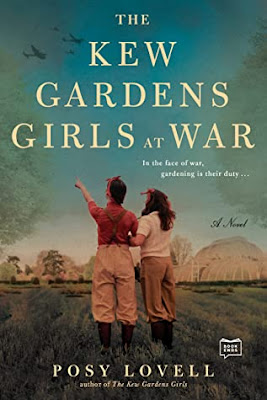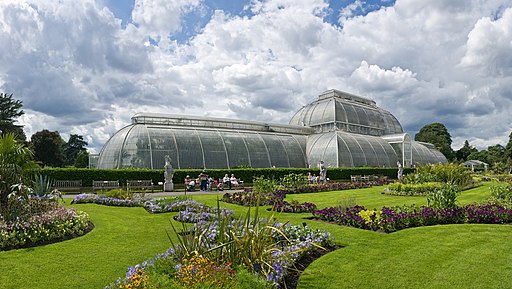I love early to mid-twentieth century fiction, particularly if they feature one of the world wars. Since I read Julia Kelly's The Last Garden in England, I've been wanting to read more historical fiction featuring gardens. Posy Lovell has two novels that explore women's rights, racial intolerance, war, and love all against the backdrop of Kew Royal Botanical Gardens in London. The first book The Kew Gardens Girls came out last year and the sequel The Kew Gardens Girls at War comes out next week. If you are like me and didn't get the first book read last year, you have time to pick it up and be ready for book two,
Amazon affiliate links are used on this site. Free books were provided for an honest review.
The Kew Gardens Girls by Posy Lovell
 |
| April 2021; G.P. Putnam's Sons; 978-0593328231 audio, ebook, print (320 pages); WWI fiction |
The Kew Gardens Girls is set during WWI. Since most male gardeners have enlisted or will soon be conscripted, the Gardens are considering hiring women. Mac, the head gardener, isn't too keen on the idea and doesn't think they are up to the task so he assigns them to weed the herbaceous border (where they can't do much damage) and move rock for the rock garden (where hopefully they will see they aren't able to do the hard work). But Louisa and Ivy are suffragettes and they are determined to prove they can do the job as well (if not better) than any man.
I haven't read as much about WWI as I have WWII so this was an interesting story. While we know London was hard hit during the latter war, the front is farther away during WWI. They still need to grow food for the war effort and part of the garden is transformed into a vegetable plot. The fight for women's vote has to take a backburner to support the boys on the front lines, but that doesn't mean they can't keep trying to improve women's lot in life. In fact, they hope the men at the top are taking notice of how well women are doing at the jobs that only men once held. Louisa and Ivy are joined by Lady Russell who is looking for something to do while her husband is leading the Dover Patrol. It is soon discovered that the female gardeners are making less than the male gardeners (even though the new male recruit Bernie has less knowledge and skills than the girls).
Conscription and the ethics of war, in general, are also themes explored in this novel. But it isn't all doom and gloom. There is love and the bonds of friendships forged out of the hardships.
I loved this novel and devoured it in big chunks over just a few days. The writing flows so well and the characters are all fleshed out. There are plenty of descriptions of plants and the gardens to add a wonderful atmosphere to the story.
Buy The Kew Gardens Girls at Amazon
The Kew Gardens Girls at War by Posy Lovell
 |
| April 2022; G.P. Putnam's Sons; 9780593419717 ebook (444 pages); WWII fiction |
A new generation of women is once again keeping Kew Gardens going while the nation marches to war. Food shortages were worse this time around and the fighting much closer to home with the London Blitz. The Department of Agriculture has two programs that the gardens are instrumental in - one is looking for medicinal plants that can be grown locally as importing medicines from the continent is near impossible, and two, help educate families on how to grow enough fruit and vegetables in a small backyard garden to keep their families fed all year long.
It is not necessary to have read the previous book (though it is so good, you definitely should), but a few of the characters play roles in this book and we get updated on everyone else from the first book.
Ivy and Jim are still living in the East End but they don't work at Kew Gardens. Instead they own a market garden. When Kew Gardens decides to open an allotment plot to educate the plot they contact Ivy. But she is too busy with her war efforts and the market garden. Her daughter Daisy has just married a RAF pilot and works a brain-numbing job of stuffing pamphlets into envelops at the War Office. Ivy remembers how much working the earth helped her while Jim was fighting in WWI and suggest Daisy go for the job.
The other main character is Beth. She is a nurse but wants to be a doctor, her parents want her married. Whle screaming her frustrations from the rooftop of the hospital she meets Gus Campell. He is also frustrated. He came to England to share his knowledge but when war broke out it was too dangerous to sail home to Jamaica. Because of the color of his skin though he is regulated to the pharmacy instead of using his skills as a cardiologists.
Daisy, Beth, and Gus wind up at Kew Gardens working on various war-related projects. Their struggles are in some way the same, but also different, than the generation that worked the gardens during WWI.
I love WWII fiction and I really love when a unique story is told. While I have read a little about land girls and the government's programs to help women feed their families with tips and recipes, I haven't heard about the medicinal plant projects. So that was definitely an interesting aspect of this novel.
Again, the characters are wonderful. I might have cried a time or two while reading this book. And I couldn't put it down and wound up staying up half the night to finish it after only having started it that morning.
I'm not sure if there will be more books about Kew Gardens, the story (as was the case with the previous book) is complete in itself but leaves open the possibility of seeing a new generation at the garden (and I hope there will be).
Buy The Kew Gardens Girls at War at Amazon
The Palm House at the Kew Royal Bontantical Garden is mentioned in both books and I found this picture online.
Donna Huber is an avid reader and natural encourager. She is the founder of Girl Who Reads and the author of how-to marketing book Secrets to a Successful Blog Tour.
Enjoyed this post? Never miss out on future posts by following us. Get even more book news in your inbox, sign up for our newsletter today! Girl Who Reads is an Amazon advertising affiliate; a small commission is earned when purchases are made at Amazon using any Amazon links on this site. Thank you for supporting Girl Who Reads.




















These books sound amazing. I will certainly be checking them both out.
ReplyDeleteThis comment has been removed by the author.
ReplyDelete